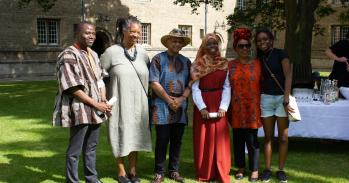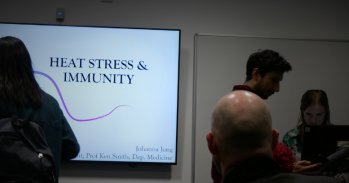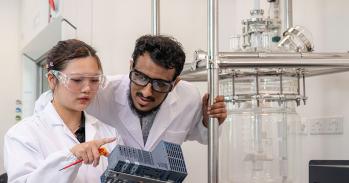
Professor Jean-Pierre Bourguignon, the President of the European Research Council, was in Cambridge on Thursday, 16 March to celebrate the ERC’s 10th anniversary.
Professor Jean-Pierre Bourguignon, the President of the European Research Council, was in Cambridge on Thursday, 16 March to celebrate the ERC’s 10th anniversary.
The ERC was created in 2007 to support innovative, high-impact research in all areas of knowledge by offering 5-year grants to outstanding scientists and scholars. Since its foundation, it has awarded €12 billion to close to 7,000 grant recipients.
The United Kingdom has been very successful at attracting ERC funding. It is the largest recipient of ERC awards, with 1,524 projects by academics based at UK institutions supported over the past 10 years.
Researchers at the University of Cambridge have won 218 of those grants, in fields ranging from Art History to Zoology. Cambridge is the greatest beneficiary of ERC grants under the current European funding programme, known as Horizon2020.
Prof. Bourguignon’s first port of call in Cambridge was the McDonald Institute for Archaeological Research, which hosted a conference to celebrate ten years of ERC-funded projects in Anthropology, Archaeology and Classics.
At the Department of Chemistry he met with researchers in the Physical Sciences who have been awarded ERC grants.
Later, at the University’s Old Schools, he attended a roundtable with Cambridge ERC-grantees in the Life Sciences and Medicine.
Commenting on his meetings, Prof. Bourguignon remarked: “For the past ten years, the European Research Council has supported high-quality research projects proposed by ambitious scientists. The five-year duration of these ERC-supported projects changes the dynamics of the research process, and allows truly ground-breaking results.”
He added: “What has been most interesting about today’s meetings is the diversity of scientific domains represented by Cambridge’s research community.”
In the evening, Prof. Bourguignon was given a tour of the Fitzwilliam Museum’s ERC-funded exhibition, “Madonnas and Miracles: The Holy Home in Renaissance Italy”. The tour was led by the exhibition’s curators, Dr Vicky Avery, Dr Mary Laven, Dr Abigail Brundin and Prof. Deborah Howard.
Following the visit, he attended a reception at the Museum in honour of the University’s ERC grantees.
Speaking at the reception, the University of Cambridge’s Vice-Chancellor, Professor Sir Leszek Borysiewicz, hailed the ERC as “one of the greatest success stories in the funding of innovative scholarship and science.”
The ERC’s commitment to scientific excellence, he said, has been uncompromising. “The impact of this commitment, over the past ten years, has been transformative.”
The Vice-Chancellor added: “Consistently, we hear from our academics that an ERC grant allows them the freedom to innovate and take risks with their research. The generous time-frame allows them to tackle big questions that they might not be able to under other circumstances.”
ERC grantees, he said, “are free to pursue their ideas wherever they may lead them, and to reformulate the question they ask, regardless of whether those ideas and those questions were part of the original plan.”
Events have been held across Europe all week to mark the ERC’s anniversary.
Bringing the University of Cambridge’s celebrations to a close, the Vice-Chancellor said:
“Tonight we thank the ERC for the support it has provided to so many of our extraordinary researchers. And tonight we thank you, our ERC grantees, who through your excellent research have turned into a reality the ERC’s aspiration of making Europe a world-leader in science and scholarship.”

The text in this work is licensed under a Creative Commons Attribution 4.0 International License. For image use please see separate credits above.




